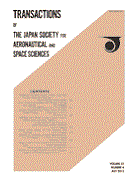All issues

Volume 58 (2015)
- Issue 6 Pages 313-
- Issue 5 Pages 253-
- Issue 4 Pages 187-
- Issue 3 Pages 113-
- Issue 2 Pages 55-
- Issue 1 Pages 1-
Volume 58, Issue 6
Displaying 1-7 of 7 articles from this issue
- |<
- <
- 1
- >
- >|
-
Hidefumi KATAOKA, Hiroyuki KATO, Keitaro SUZUKI, Sakiko ISHIHARA, Kazu ...2015Volume 58Issue 6 Pages 313-318
Published: November 01, 2015
Released on J-STAGE: November 04, 2015
JOURNAL FREE ACCESSLaser ablation is expected to achieve the direct initiation of detonation with a smaller amount of energy compared to laser breakdown. In the present work, the critical energy for direct initiation was experimentally studied with an acetylene/oxygen mixture varying the distances between the focal point of the laser beam and the target surface. The observed plasma formation in the laser ablation is divided into three modes: (a) the plasma generated by laser ablation is attached to the target surface; (b) the breakdown plasma partly overlaps with the ablation plasma; and (c) the breakdown plasma is formed separately from the ablation plasma. The dependence of the critical energy for the laser ablation on the distance between the target surface and the focal point is explained by interaction between the breakdown and the ablation plasma. The present results demonstrate that it is possible to initiate detonation directly using laser ablation with much smaller laser energy compared to laser breakdown.View full abstractDownload PDF (2811K) -
Tomoaki ISHIHARA, Yousuke OGINO, Naofumi OHNISHI, Hideyuki TANNO2015Volume 58Issue 6 Pages 319-326
Published: November 01, 2015
Released on J-STAGE: November 04, 2015
JOURNAL FREE ACCESSUnexpected heat flux augmentation in a free-piston high-enthalpy shock tunnel (HIEST) was numerically analyzed. Since a previous experimental study implied that the radiation heating from the shock layer caused the augmentation, a three-dimensional thermochemical non-equilibrium CFD code including radiation transport calculation in the shock layer was developed. This calculation was conducted under the following models: 1) Radiation heating from the air species in the shock layer was calculated by a solving radiative transport equation using tangent slab approximation; and 2) Radiation heating from impurities such as carbon soot and metal particulates, which could be included in the upstream test gas, was calculated by assuming the shock layer as a grey body with averaged shock layer temperature for a trial calculation. The calculations were performed at the stagnation enthalpy and stagnation pressure from 7 to 21 MJ/kg and 31 to 55 MPa, respectively. For air species radiation, radiative heat flux was too small to contribute heat flux augmentation. On the other hand, for grey body assumption, we could find that abnormal heat flux augmentation could be expected by ε σ Tave4 for an engineering technique, where ε denotes the emissivity ε = 0.132 and Tave4 was the average shock layer temperature.View full abstractDownload PDF (2213K) -
Rei YAMASHITA, Kojiro SUZUKI2015Volume 58Issue 6 Pages 327-336
Published: November 01, 2015
Released on J-STAGE: November 04, 2015
JOURNAL FREE ACCESSThis study describes an application of full-field, direct simulation in the entire domain involving the near-field around an aircraft, the far-field toward the ground, and the caustic region as an approach to investigate sonic boom cutoff phenomena. A flow field around an axi-symmetric paraboloid has been analyzed by solving three-dimensional (3D) Euler equations with a gravity term for considering atmospheric stratification with altitude. A solution-adapted grid is constructed to align the grid lines with front and rear shock-wave surfaces. The flight is assumed to have a speed of Mach 1.1 at an altitude of 10 km. This study presents the world's first successful numerical simulation for a 3D structure of cutoff phenomena. The results show that the incoming wave generated from the paraboloid is divided into an outgoing wave in the upward direction and an evanescent wave in the downward direction at the cutoff altitude by the diffraction effect. In the cutoff region, the sonic boom reaches the peak intensity by focusing the rays. The evanescent wave under the cutoff region is reduced rapidly. Moreover, the shape of the cutoff surface is obtained for sonic and lateral cutoffs.View full abstractDownload PDF (1864K) -
Takashi IWASA, Hiroyuki TANAKA, Motoharu FUJIGAKI2015Volume 58Issue 6 Pages 337-344
Published: November 01, 2015
Released on J-STAGE: November 04, 2015
JOURNAL FREE ACCESSThis paper proposes a measurement method to capture the surface profiles of vibrating objects with high spatial resolution. The proposed method is a one-shot surface shape measurement using a grating projection method, which incorporates a Wiener filter to reduce the random error. The measured objects are a white flat plate and a polyimide film with wrinkles. The random errors treated in this study are error components that appear in the depth direction of the photogrammetric measurement. By experimental measurement of stationary objects, it is clarified that the spatial distribution of random errors is roughly Gaussian. On the basis of this result, a Wiener filter is applied as a random error reduction method for the one-shot surface shape measurement using the grating projection method. Its effectiveness is discussed by conducting the shape measurement of the white plate model and the polyimide film. The results show that the proposed method can remove random errors from the measurement results with the same effectiveness as a traditional averaging procedure. Moreover, it is also shown that the proposed method can appropriately reduce random errors in the surface shape measurement results of vibrating objects.View full abstractDownload PDF (4429K)
-
2015Volume 58Issue 6 Pages 345-346
Published: 2015
Released on J-STAGE: November 04, 2015
JOURNAL FREE ACCESSDownload PDF (53K) -
2015Volume 58Issue 6 Pages 347-348
Published: 2015
Released on J-STAGE: November 04, 2015
JOURNAL FREE ACCESSDownload PDF (50K) -
2015Volume 58Issue 6 Pages 349
Published: 2015
Released on J-STAGE: November 04, 2015
JOURNAL FREE ACCESSDownload PDF (46K)
- |<
- <
- 1
- >
- >|